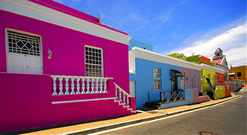CapeTown: The Mother City
 A Jet Set Capital
A Jet Set Capital
There are a handful of highly cosmopolitan cities that decorate the global travel map – Rio, Sydney and Buenos Aires to name but a few – that all have in some way the attributes of beauty, grandeur, romance and fine living. The common perception of Africa, however, tends to preclude a lot of these qualities, but it often comes as a very pleasant surprise to the fist time visitor to the continent to find that amongst these international urban jewels is the South African city of Cape Town.
In fact, for the first timer, South Africa itself hardly seems like Africa at all. With its clean and ordered cities, its superb transport and communication infrastructure, and its sophisticated cultural and business forums, it could hardly be further removed from the popular image of the continent. South Africa is Africa for beginners – a perfect springboard for the wider reach of a continent that will in every respect satisfy the expectations of the adventure hungry outfield traveler.
Cultural Heartland
Cape Town is the cultural heartland of South Africa, and as such it represents a nation of dazzling ethnic diversity. Its history, in nutshell, is one of cultural merger and clash. The agents of the Dutch East India Company arrived on the peninsular in 1652 to establish a resupply station for Company shipping, and almost a century later confronted the downward spread of the Bantu people migrating south from the African heartland. In the meanwhile Khoisan natives, imported Malay bonded workers, slaves from Madagascar and the East African
coast, French religious refugees, Indians, Arabs, British and a polyglot assortment of Europeans all arrived to enrich and enliven the mix. The Cape was the first British colony to be established in the region, and the first to have a functioning seat of government and a Westminster style legislature, and moreover, until the opening of the Suez Canal in 1869, it was one of the most important shipping entrepôts in the world.
Climate
Perhaps the primary catalyst for the explosion of cultural growth that followed the establishment of the first settlement was the temperate, sub tropical climate that arch imperialist Cecil John Rhodes once remarked was one that a white man could well live in. Certainly it is a far cry from the ‘white man’s grave’ of Central and West Africa that famously afforded early European colonists an average life expectancy of just nine months. These sublimely pleasant airs, combined with both the natural gifts of peninsular and the agrarian skills of early
Huguenot settlers, laid the foundation of the now celebrated wine industry of the region, which itself set in motion a process of gentrification, and the subsequent growth of the unique style, architecture and cuisine of the Cape.
Cape Malay
Contemporary Cape cuisine, of course, is by now a great deal more varied than its original continental and European root, which has over generations been grafted with the piquant buds of Afrikaner, Indian and Malay influence, to create the distinctive Cape Malay style that is now both ubiquitous throughout the region and justifiably famous.
Liberal Culture
Cape Town is also known for its liberal outlook, with nightclubs catering for every sexual preference, and restaurants and eateries considered to be among the finest in the world. Festivals and carnivals reflect the city’s cultural diversity, as does the arts scene that is doubtless the most varied and sophisticated on the continent. Capetown is also a maritime city with the Simonstown Naval Base, a bounty of fresh seafood, and a number of well known and popular beaches that lead off either the Atlantic or Indian Oceans, each with a considerable temperature variation depending on what side of the peninsular is preferred. Table Mountain itself, the iconic landmark of the Mother City, can be accessed on foot or by cable expressway, and around the skirt of the Berg are many scenic walks and drives.
This synthesis of cultural diversity, of blended European, oriental and African traditions, of old and new, of black and white, can best be absorbed through the sophisticated and functional local hospitality industry. Spreading north and east from the Mother City the famous Garden Route follows the south coast to the wineland with its multiplicity of lodges, country homes, spas and and bed & breakfast establishments. The coast itself is punctuated by hamlets and villages where, as well as the usual pleasures of stylish accommodation, fine eating and wine tasting, are some of the best whale watching sites in the southern hemisphere. From there the road leads east and northeast into the South African heartland, where the more rugged appeal of mountains and bushveld opens the way north to wild Africa.
Food & Drink
If you are looking for a cultural tour in the ultimate food and drink comfort zone, with a just enough rugged appeal to remind you that you are in Africa, then the Cape is for you. If you want an easy start to the challenge of long-range travel north towards the equator, then the Cape is for you. If you want to slake your thirst after a journey south through the wild regions of Namibia and Botswana, then equally the Cape is for you. Or if you simply want to visit one of the worlds’ premier cities, the site of great history, great culture and great times, then the Cape is for you.